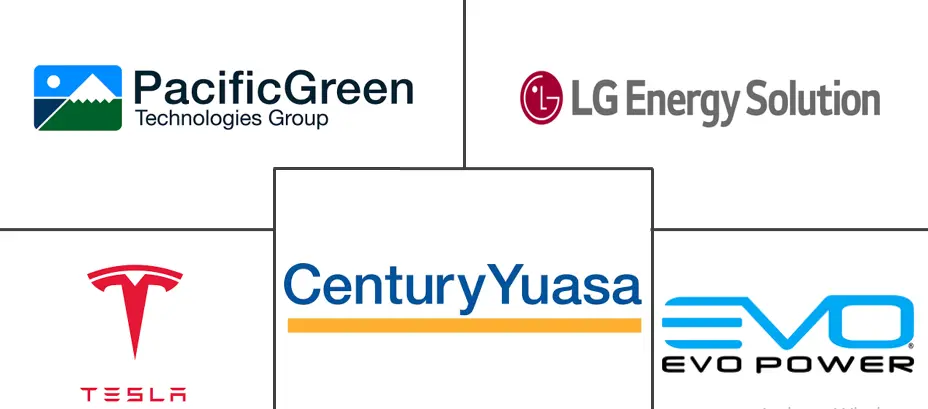Market Size of Australia Energy Storage Systems (ESS) Industry

| Study Period | 2021 - 2029 |
| Base Year For Estimation | 2023 |
| Forecast Data Period | 2024 - 2029 |
| Historical Data Period | 2021 - 2022 |
| CAGR | 27.56 % |
| Market Concentration | Medium |
Major Players
*Disclaimer: Major Players sorted in no particular order |
Australia Energy Storage Systems Market Analysis
The Australian energy storage systems (ESS) market is expected to reach USD 8,656 million by the end of the current year, and it is projected to register a CAGR of -27.56% during the forecast period.
Although the market studied was affected by the COVID-19 pandemic in 2020, it recovered and reached pre-pandemic levels.
The decrease in prices of batteries and rapid adoption of renewable energy supported by government initiatives are expected to drive the growth of the market studied during the forecast period.
However, high initial capital requirements, along with the high cost of the components, are anticipated to restrain the demand for energy storage from the residential and small-scale commercial sectors, thus, inhibiting the growth of the market studied.
The development of new advanced batteries and the increasing commercialization of compressed air energy storage (CAES) technology is expected to create several opportunities for Australian energy storage systems (ESS) providers.
Australia Energy Storage Systems Industry Segmentation
An energy storage system (ESS) is a device or group of devices assembled to convert the electrical energy from power systems and store energy to supply electrical energy at a later time when needed.
The Australian energy storage systems (ESS) market is segmented by type and end user. By type, the market is segmented into battery energy storage systems (BESS), pumped-storage hydroelectricity (PSH), and other types. By end user, the market is segmented into residential, commercial and industrial, and utility scale. For each segment, the market sizing and forecasts have been done based on revenue (USD million).
| By Type | |
| Battery Energy Storage System (BESS) | |
| Pumped-storage Hydroelectricity (PSH) | |
| Other Types |
| By End User | |
| Residential | |
| Commercial and Industrial | |
| Utility Scale |
Australia Energy Storage Systems (ESS) Market Size Summary
The Australian energy storage systems market is poised for significant growth, driven by the decreasing costs of batteries and the rapid adoption of renewable energy sources, supported by government initiatives. Despite the initial impact of the COVID-19 pandemic, the market has rebounded to pre-pandemic levels. However, challenges such as high initial capital requirements and the cost of components may restrain demand, particularly in the residential and small-scale commercial sectors. The development of advanced batteries and the commercialization of compressed air energy storage technology present new opportunities for market players. Battery energy storage systems are crucial for transitioning to a sustainable energy system, offering benefits like voltage and frequency regulation, peak demand charge reduction, and renewable source integration. Lithium-ion batteries, in particular, are gaining traction due to their low maintenance, lightweight nature, and high energy density.
The renewable energy sector in Australia is experiencing robust growth, with solar, wind, and hydro power contributing significantly to the energy mix. The declining costs of renewable power generation, driven by innovations and economies of scale, are making it more competitive compared to conventional power sources. As renewable energy's share in the National Electricity Market is expected to double by 2030, the demand for energy storage applications is anticipated to rise. Government and private sector efforts are focused on large-utility-scale renewable projects, further bolstering the energy storage market. The market is moderately fragmented, with key players like Pacific Green Technologies Group, LG Energy Solution Ltd, and Tesla Inc. actively participating. Upcoming projects, such as the proposed solar facility and battery storage in Western Australia, are expected to enhance the market's growth trajectory during the forecast period.
Australia Energy Storage Systems (ESS) Market Size - Table of Contents
-
1. MARKET OVERVIEW
-
1.1 Introduction
-
1.2 Market Size and Demand Forecast in USD million, till 2027
-
1.3 Recent Trends and Developments
-
1.4 Government Policies and Regulations
-
1.5 Market Dynamics
-
1.5.1 Drivers
-
1.5.2 Restraints
-
-
1.6 Supply Chain Analysis
-
1.7 PESTLE Analysis
-
-
2. MARKET SEGMENTATION
-
2.1 By Type
-
2.1.1 Battery Energy Storage System (BESS)
-
2.1.2 Pumped-storage Hydroelectricity (PSH)
-
2.1.3 Other Types
-
-
2.2 By End User
-
2.2.1 Residential
-
2.2.2 Commercial and Industrial
-
2.2.3 Utility Scale
-
-
Australia Energy Storage Systems (ESS) Market Size FAQs
What is the current Australia Energy Storage Systems (ESS) Market size?
The Australia Energy Storage Systems (ESS) Market is projected to register a CAGR of 27.56% during the forecast period (2024-2029)
Who are the key players in Australia Energy Storage Systems (ESS) Market?
Pacific Green Technologies Group, LG Energy Solution Ltd, Tesla Inc., EVO Power Pty Ltd and Century Yuasa Batteries Pty Ltd are the major companies operating in the Australia Energy Storage Systems (ESS) Market.

